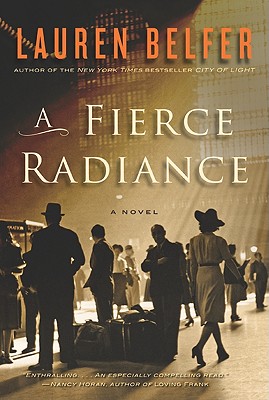Lauren Belfer, today's guest blogger and author of A FIERCE RADIANCE, is an amazing storyteller. Just by talking about how she researched her book and sharing some of the real tidbits she uncovered she has completely drawn me in. A FIERCE RADIANCE will definitley be on my "must read" list.
 A FIERCE RADIANCE, my new novel, tells the story of Claire Shipley, a photojournalist with
A FIERCE RADIANCE, my new novel, tells the story of Claire Shipley, a photojournalist with
Life Magazine who stumbles upon the story of her career when, in the tumultuous days after the Japanese attack on Pearl Harbor in 1941, she’s assigned to New York’s mysterious Rockefeller Institute to report on the testing of a miraculous new drug, penicillin. As the United States enters World War II, penicillin becomes a weapon of war, its top-secret development supervised by the same government group that’s managing the atomic bomb project. Claire finds herself drawn into the web of intrigue which surrounds penicillin and similar life-saving medications, those which we now call antibiotics.
As I set out to recreate the American home front during the Second World War, I strove
to forget everything I knew about the actual course of the war and instead put myself into the shoes of people living those years from day to day, not knowing what the future would bring. I read every issue of Life Magazine from 1939, when the war began in Europe, through 1945, when the war ended. I read years of the New York Times on microfilm. The Times archive is available online, but microfilm was much better for my purposes, because it showed me the advertisements as well as the short announcements and articles that often appear at the top and bottom of the pages and contain a wealth of information.
By systematically reading Life and the New York Times, I discovered a home front I’d known nothing about. For example, from our perspective in 2010, we know very well that American cities were never bombed during World War II. But during those years, people expected that American cities would be bombed. I read article after article on how to prepare your family and your home for bombing raids. Many of these stories were quite touching. For example, pets were forbidden in air raid shelters, and Life ran a photo essay on how to prepare dogs and cats for air raids. Dogs were supposed to be leashed to the foot of the bathtub or to the bathtub faucet, and left with a chew toy and a bowl of water. Cats were to be put in boxes or crates next to the dog and also given a toy and a bowl of water, while families went to the air raid shelters.
During the first winter of the war, invasion was considered not just possible but likely. Life predicted that the enemy would take a three-pronged approach: Japanese forces would move through Alaska and into the Pacific Northwest, while the Germans would simultaneously attack New York City and New Orleans, moving north along the Mississippi River valley to divide the nation. Americans were told to sabotage infrastructure facilities to prevent them from falling into enemy hands. Reading advice on how Americans should blow up their own bridges and rail lines to keep them from the enemy truly brought the war home to me. I was forced to confront what my role might have been if the country were invaded, and how I would have protected my family.
Not everything I learned in my research was so bleak, however. I took great pleasure in reading the advertisements in Life and in the Times. By reading the ads, I learned the latest
styles in suits, dresses, and automobiles. In the Times, I learned what was on sale at Macy’s, so if Claire Shipley needed news shoes, say, she could buy them at a good price. Of course I could have invented these details, but using the reality whenever possible made the scenes more immediate for me and also, I hope, for my readers. One advertisement in particular has haunted me: this was an ad in the New York Times, placed by Bonwit Teller, for cashmere sweaters imported from Scotland. The ad said the sweaters had survived the Battle of the North Atlantic to get to Bonwit’s and that we Americans had a responsibility to help our British allies by buying these sweaters. Nowadays, we tend to be cynical about advertising, but that ad brought tears to my eyes. I wanted to go right to Bonwit’s and help Britain by buying a sweater!
As you read A FIERCE RADIANCE, I hope the struggles and triumphs of the war years will become as compelling for you as they were for me, as I researched and wrote the novel.

